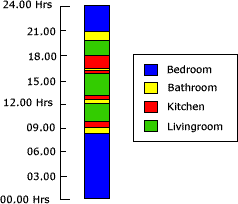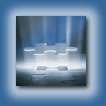How Does Sensor Output Analysis Work?
Step 1. Gathering Data
The Sensor Network sends changes in sensor values to a Database from the Data Acquisition Blocks.
The Database then records the data in a file under the three main headings: Timestamp (the time at which the sensor activated), Device ID (the sensor's unique identification number) and Value (the change in sensor value).
Step 2. Training The Models
Dundee is using a system of switches mounted beside the doorway to each room as a simple method of supplying test data to allow the mathematical models to be trained.
As a user enters or leaves a room, they hit a small switch mounted by the door. The change in value from the switch is recorded in the database, giving an accurate representation of the user's movements through the home as well as their current whereabouts.
This data can then be compiled and used to train the models, allowing the system to become very accurate at calculating probability data for different scenarios.
An example would be to predict a user's movements within the home based on their past movement patterns.
If we knew, for example, that a user has lunch at a certain time of the day, the system could use probabilities to work out that a user leaving the living room at this time will in fact walk through the hallway and then go to the kitchen.
The results from the models will also give transition probabilities from room to room, e.g. what the busiest room is.
Step 3. Using The Models
Once the models have been trained and are deemed to be accurate enough, the models can be used to analyse the wider range of test data. The probability figures created by these can then be used by the system to interpret different factors such as what is the most used room and what is the most common route to the kitchen.

The results also offer a useful insight into which room a person is generally in at certain points of the day. For example, between 9.00 AM and 9.30 AM the user may always be in the kitchen getting breakfast. From 10.30 AM to 12 noon they may be in the living room watching TV.
This diagram is an example of how modelling data like this can be displayed visually:
Future analysis is planned which will extend these abilities even further using technology such as chair sensors in the seat cushions. These sensors will provide data on the mobility of a user over time. If a user starts to drop themselves into a seat rather than sitting down naturally, this could be noticed. The probability of the user declining in mobility could be supplied to care staff.


